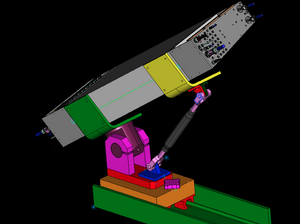Feb 28, 2012 Calorimetry
From GlueXWiki
Teleconference Time: 11:00 a.m. EST'
- ESNET (Number is 8542553) and EVO session (GlueX Calorimetry meeting room)
- Phone connection only upon request.
- +1-866-740-1260 : US+Canada
- +1-303-248-0285 : International
- then enter participant code: 3421244# (remember the "#").
- or www.readytalk.com (and code without the #)
Contents
Participant Direct Lines
- JLab Phone: in CC F326 is 757-269-6337 (usual room)
- JLab Phone in CC L207 is 757-269-7084
- Phone in the Regina Videoconference Suite is 306-585-4204
- Athens Phone: in Christina's office is 011-30-210-727-6947
Items for followup from previous meeting(s)
- Monitoring
- Send additional SiPMs to Athens for tests (Elton). Boards have been fabricated, but still need testing.
Tentative Agenda
- Announcements
- Review of Action Items
- Monitoring. Media:FirstLEDassemblies.ppt
- FCAL
- Construction Status: mechanical, bases (notes from Matt)
- Paul and I both visited Total Electronics (the vendor for the CW bases) last Thursday. We went through a variety of issues regarding coating and assembly. They appear to understand where their procedure is deficient. Again, they are saying all the right things. The big question is: will the next batch of boards show improvements in production quality? We'll see.
- Beam tests in Hall B (John)
- small note on distance from CLAS scintillators by Kei
- Construction Status: mechanical, bases (notes from Matt)
- BCAL
- BCAL Beam Tests 2012
- LG gluing schedule and LED attachment by tape
- BCAL Beam Tests 2012
- USM update
- TDR update
- Instructions for the TDR (You must be logged into the wiki to access this page).
- We need to start revising Chapter 4 Detector, Section 4.3 Calorimetry.
- Simulations/Reconstruction
- Any other business
Minutes
Attending: Elton, Eugene, John D., Beni, Yi, David, Sasah, Tim, John L. (JLab); Christina, George, Pavols (Athens); Zisis, George (UofR); Will, Hayk, Javiera, Sergei, Orlando (USM);
- Announcements
- Review of Action Items
- Monitoring. Media:FirstLEDassemblies.ppt
- 40 Bcal boards received and tested. Ready to ship
- Gain variation measured with 6x6 mm2 photodiode. Signal sizes range from 0.6-1.2 V
- Could investigate grouping the LEDs according to intensity
- Eugene: Asked about uniformity of light output at the near side. Athens agreed to study the systematics and robustness of assembly.
- Christina: Indicated that the "flexible" cable is not very flexible and might need modification for the final setup.
- FCAL
- Construction Status: mechanical, bases (notes from Matt)
- Paul and I both visited Total Electronics (the vendor for the CW bases) last Thursday. We went through a variety of issues regarding coating and assembly. They appear to understand where their procedure is deficient. Again, they are saying all the right things. The big question is: will the next batch of boards show improvements in production quality? We'll see.
- Beam tests in Hall B (John)
- small note on distance from CLAS scintillators by Kei
- John reported that they are sorting out the combined Hall B/Fcal data taken. The data with the Fcal trigger looks good. The data with the T-counter triggers have very few hits. Will likely request additional data be taken once all the issues with the present data set are understood.
- Construction Status: mechanical, bases (notes from Matt)
- BCAL
- BCAL Beam Tests 2012
- LG gluing schedule and LED attachment by tape
- Sasha has added the list of electronics to the wiki
- BCAL Beam Tests 2012
- USM update
- Production Manager Report (Javiera)
- Javiera compared data for the width the rise time of pulses taken with the array inserted upside-down. The systematics shown last week follow the electronic channel indicating that it is probably due to the amplifiers (not the sensor).
- Also showed scope traces for the summed array output illuminating the entire array and illuminating a single cell. The widths were only slightly less for the single cell.
- Station 3: Crosstalk vs. temperature (Hayk)
- Only 5 positions in stage with with remaining problems.
- Showed data showing fits that indicate that the x-talk depends on temperature, however there are several reasons that the data sets are not directly comparable.
- Yi: Conducted several fitting tests. Finds that a fit to the entire spectrum is independent of temperature, but fits to 3 peaks (method used by USM) at a time show some systematics.
- Issue: Jump in apparent amplifier gains: Problem solved: Orlando found that the positive-going pulse that accompanies the usual negative pulse in the amplifier gain calibrations causes the V792 ADC to misbehave. The gain calibration hardware has been modified to eliminate the effect of this pulse.
- Production Manager Report (Javiera)
- TDR update
- Instructions for the TDR (You must be logged into the wiki to access this page).
- We need to start revising Chapter 4 Detector, Section 4.3 Calorimetry.
- No update this time.
- Simulations/Reconstruction
- Any other business
